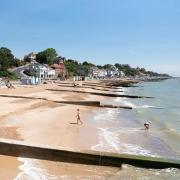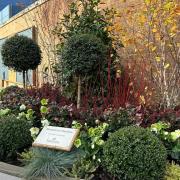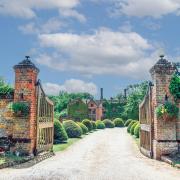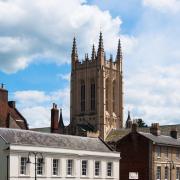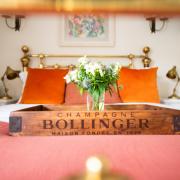From quaint, seaside market towns to pretty, chocolate-box villages and historic hamlets, Suffolk is rich in places with stories to tell. Whether you're visiting the county or you call Suffolk home, you'll find plenty in its heritage to fascinate and delight. So, why not plan a short break and get to know it better? Look beneath the surface and Suffolk is a county of continual discovery.

Ipswich
Ipswich is one of England’s oldest towns (arguably THE oldest). It's famous as the birthplace of Cardinal Thomas Wolsey, Henry VIII’s almoner. The town is now celebrating the 550th anniversary of Wolsey's birth, with a programme of events held over 550 days (ipswichcentral.com/news-and-events/tw550). His statue is at the junction of Saint Nicholas and Saint Peter’s Streets, where he is said to have lived as a child, and there's an exhibition at The Hold (Suffolk Archives) until October 29. Ipswich's medieval Saints area is home to boutiques, gift galleries and artisan coffee shops and a five-minute stroll to the Waterfront, where you can relax at one of the bars, cafés and bistros, or cruise the beautiful River Orwell aboard the Orwell Lady, Sailing Barge Victor or Allen Gardiner River Cruise Restaurant. There's more heritage at Christchurch Mansion, Ipswich Transport Museum, and Ipswich Museum, which is undergoing redevelopment and due to reopen in 2025. For entertainment in Ipswich visit the Jerwood DanceHouse, Regent Theatre, Corn Exchange, or the New Wolsey Theatre.
What’s on:
- Spill Festival 2023, multiple venues, October 13-29
- The Saints Festive Street Market, St Peter’s Street, November 26
- Festive Artisan & Producer Market, Cornhill, December 12

Bury St Edmunds
The home of Saint Edmund, the original patron saint of England, Bury St Edmunds belongs to a dramatic time in English history. The Abbey, now ruined, was one of the richest and most powerful Benedictine monasteries in England. In the Abbey Gardens you can see the extensive remains and picnic by the River Lark. Visit St Edmundsbury Cathedral with its beautiful Millennium Tower, Moyses Museum, and the Guildhall for more local history. Bury St Edmunds has a wide variety of restaurants, pubs and cafés. Bury St Edmunds Food and Drink Festival takes place every August, there's a monthly farmers' market and a bi-weekly traditional market. The town is also the home of Greene King. Take a tour of the historic brewery and enjoy great views from the rooftop. For evening entertainment there's the Theatre Royal Bury St Edmunds, Britain's oldest surviving Restoration theatre, while the Apex, also in the heart of town, offers a full programme of music, from pop, rock and jazz, to blues, folk and classical, as well as comedy and dance performances.
What’s on:
- Bury St Edmunds Lit Fest, Unitarian Meeting House, October 20-22
- Christmas Craft & Gin Fair, The Athenaeum, November 19

Felixstowe
Felixstowe has a fascinating history as a Victorian and Edwardian spa town which prospered with the development of the port at Landguard Peninsula. It's now the UK's biggest container port and at the viewing point you can watch giant container ships come and go, as well as explore this area's fascinating military and social history at Landguard Fort and Felixstowe Museum, and visit the bird observatory and nature reserve. Felixstowe's shingle/sand beaches are bordered by the award-winning Seafront Gardens gardens in the north, while the southern part is where you'll find amusements, cafés, and Beach Street, a colourful community of shipping containers where you can eat, drink and shop. Felixstowe Pier offers arcade games and a casino, plus the The Boardwalk Café Bar, while at the Spa Pavilion there's great food and top class entertainment. At Felixstowe Ferry, a fishing hamlet at the mouth of the River Deben, you can watch boats, get a cuppa and a bite to eat, and in season board the ferry to visit Bawdsey Radar museum.
What’s on:
- Love Felixstowe Festival (includes Art of the Prom), September 2-3
- The Drifters in Concert, Spa Pavilion, October 7

Framlingham
Framlingham is known for its magnificent castle, built in the late 12th century by the powerful Norman Bigod family, and home to the dukes of Norfolk and Mary Tudor, who was famously proclaimed queen there. Walk the walls, admire the views, visit The Lanman Museum, café and shop. There's also a full programme of events throughout the year. The castle is bordered by The Mere, a reserve cared for by Suffolk Wildlife Trust, where you can walk and see wildlife. In the centre of Framlingham, you'll find St Michael’s Church and the Framlingham War Memorial. Around the market square and in the side streets are clustered independent shops and, cafes and restaurants. There's a market every Tuesday and Saturday.
What’s on:
- Fram Horticultural Society: Autumn Show, United Free Church Hall, September 16
- Ghost Tales at Framlingham Castle, October 27, 23 and 31

Southwold
Famous for its sandy beaches, colourful beach huts and fun-filled pier with its arcade, fish and chip shop/restaurant, Wacky Walk of Mirrors and Under the Pier Show. Climb aboard Coastal Voyager and spot seals at Scroby Sands; wander wild Denes Beach; visit the lifeboat station and museum at the harbour; climb to the top of the lighthouse, visit Southwold Model Boating Lake with its 1940s-style tearoom, model boat races, paddleboats and adventure golf course; enjoy a tour of Adnams' brewery and distillery. There's also the vintage Electric Picture Palace cinema, impressive St Edmunds church, Southwold Museum and the Sailors’ Reading Room, where you can find more maritime history. There's a full entertainment programme at Southwold Arts Centre in St Edmunds Hall.
What’s on:
- Alice in Wonderland by Dot Productions, St Edmund’s Green, September 3
- Antiques, Vintage & Collectors Market, United Reformed Church Hall, October 21

Aldeburgh
Once an important Tudor port, Aldeburgh's fortunes waned, then thrived again in the 1900s thanks to a surge in holidaymakers seeking the sea air. Aldeburgh is always a popular destination for daytrippers who come for great fish and chips, best enjoyed with a view of the sea. Walk south to Slaughden and its Martello tower, or head north to the village of Thorpeness, passing Maggi Hambling's Scallop sculpture. Aldeburgh is best known as the home of composer Benjamin Britten, founder of the Aldeburgh Festival held every June in the town and at nearby Snape Maltings. Year-round, you can visit The Red House, the home shared by Britten and his partner Peter Pears. Don't miss the Moot Hall where Aldeburgh’s rich history comes to life and the Norman cSt Peter and St Paul's church, where Dr Elizabeth Garrett Anderson, Britain's pioneering female physician is buried.
What’s on:
- Aldeburgh Food & Drink Festival 2023, Snape Maltings, September 23, 24
- SHAKE Festival, a celebration of Shakespeare, Jubilee Hall, October 7-8
Newmarket
Famous as the home of thoroughbred horse racing. You can enjoy a day at one of the two racecourses, Rowley Mile and the July Course, and guided tours of the town's horseracing highlights are operated by Discover Newmarket. These can include visits to the National Stud and the National Horse Racing Museum, as well as private racing yards. Dine and stay at the historic Jockey Club Rooms, the place where it all started when a group of racing enthusiasts got together to discuss fair racing rules at Newmarket’s Heath. The Jockey Club became the official governing body for horse racing in Britain. Walk the Gallops, otherwise known as the Heath, 2,500 acres of training grounds where public access is allowed after 1pm every day (after 11am on Sundays).
What’s on:
- Suffolk Punch Horses on display, National Horse Racing Museum, October 1
Halesworth
A centre for the arts and home to the annual INK Festival, which champions new play writing. Visit Halesworth Gallery and The Cut Arts Centre, which stages performances of all kinds and hosts exhibitions, classes and special events. To explore Halesworth's history it's worth visiting Halesworth and District Museum, as well as Halesworth (Holton) Airfield Museum, where the 56th Fighter Group of the United States 8th Army Air Force were stationed during World War II. Halesworth has a lively pedestrianised Thoroughfare with delis, cafés and restaurants. Market day is every Wednesday, and a country market is held on Friday mornings at St Mary’s Church Hall.
What’s on:
- Illustrations and Sculpture exhibition, Halesworth Gallery, September 1

Leiston
Leiston is famed as a centre for engineering and manufacturing during the 19th and 20th centuries, when Richard Garrett and Sons’ built their factory for quick assembly of portable steam engines, tractors and agricultural machinery. Part of the old works remains at The Long Shop Museum, where you can see the machinery and learn all about it. The monastic ruins of Leiston Abbey are just a mile from the town. Music school Pro Corda occupies the site, which is managed by English Heritage. Visitors can look around at no charge. Leiston has Suffolk’s oldest operating cinema, Film Theatre Leiston (formerly Leiston Picture House), which opened its doors in 1914. It screens the latest blockbusters as well as much-loved classics, theatre productions, including two annual pantomimes.
What’s on:
- ABBA Sensation, Leiston Film Theatre, October 6

Beccles
A must-visit in the southern Broads. Enjoy a walk around the marina, along the River Waveney or through Beccles Marsh Trail. Beccles Food and Drink Festival and the Beccles Antiques Market, both take place in May. Antiques can also be found at Beccles Museum at Leman House. The collection spans various eras from Roman to Victorian and houses a community cabinet where members of the public can display their own items of historical interest. St Michael’s Church is a well worth a visit with its 16th century bell tower. You can swim at Beccles Lido, hire a boat at Hippersons Boatyard or pay a visit to nearby Ellough for a skydiving adventure at UK Parachuting.
What’s on:
- Christmas Light Switch On, November 24

Bungay
Situated in the Waveney Valley, Bungay is a traditional market town with a central Market Place marked by its historic Butter Cross and Justice statue. Nearby are the ruins of the old Benedictine priory and the remains of Bungay Castle. St Mary’s Church is famous for the legend of Black Shuck, the demon dog said to have terrorised worshippers sheltering from a storm August 4, 1577. The Black Shuck Festival celebrates the legend each August with folklore, costumes and storytelling. Bungay has plenty of independent shops and places to eat – delis, restaurants and pubs, breweries and vineyards in and around the area. The Fisher Theatre, which opened in 1828, still stages productions and regularly screens films, old and new.
What’s on:
- Christmas Market, December 3

Orford
Famed for its well-preserved 12th century castle keep, with a unique polygonal tower, where Orford Museum Trust stages a permanent exhibition telling the history of the castle and town. Also worth visiting is the Grade I Listed St Bartholomews Church and Orford Museum, which explores the history of the six parishes of Orford and Gedgrave, Sudbourne, Iken, Chillesford, Butley and Tunstall. At Orford Quay you can take a boat across to Orford Ness National Nature Reserve to discover the fascinating military history of the shingle spit, where radar was first developed and atomic weapons were tested.
What’s on:
- Island of Secrets Walk, National Trust Orford Ness, October 7

Woodbridge
Woodbridge's history is tied up in rope-making, sail-making and boat-building (Sir Francis Drake had his fighting ships built here). It's a busy town on the River Deben, with plenty of independent shops, restaurants, cafes and galleries. You can visit the historic Tide Mill, the oldest still working in the UK and the redeveloped Quay. Across the river lies Sutton Hoo, the site of an Anglo Saxon ship burial, now in the care of the National Trust.
What's on:
- Woodbridge Festival of Art and Music, September 1-3
- Riddlequest: Escape Game at Sutton Hoo, Spetember 29, November 17, 18

East Bergholt and Dedham
The birthplace of artist John Constable. Visit St Mary’s Church with its unique set of bells, housed in a bellcage, which are rung every Sunday from 9.30am. The neighbouring hamlet of Flatford is the place to explore John Constable's world – the iconic mill, lock, and Willy Lott’s house, settings for his paintings, are in the care of the National Trust. You can take a boat on the river, and visit the wildlife garden. Nearby Dedham is where Constable went to school, and was home to artist Sir Alfred Munnings and his wife, Violet. The Munnings Art Museum contains the collection that earned Munnings his reputation as a prolific painter. Dedham Vale, also known as Constable Country, is an Area of Outstanding Natural Beauty and has beautiful walks through along the River Stour through landscapes that inspired Constable.
What’s on:
- Flatford Nature Day, Flatford National Trust, October 24
THE WOOL TOWNS
Some Suffolk towns and villages owe their postcard-pretty looks to the years when the county was at the centre of England's lucrative cloth industry. Good pasture, numerous rivers and access to ports here and in Europe made Suffolk a perfect place in medieval and Tudor times for raising sheep, processing wool, spinning, dyeing, weaving and exporting. Merchants grew wealthy, built grand timbered houses, ploughed money into churches and other public buildings.

Sudbury
As well as wool, Sudbury is known for its history of silk manufacturing, celebrated in a biennial Sudbury Silk Festival. Local mills still weave fabric for customers all over the world today. It's also the birthplace of painter Thomas Gainsborough. The refurbished and extended Gainsborough’s House shows his work, as well as that of John Constable and Cedric Morris, who were inspired by him, and hosts temporary exhibitions throughout the year. Guided tours and walking trails explore the history and architecture of Sudbury. Spend time in the ancient water meadows and visit Sudbury Heritage Centre & Museum.
What’s on:
- Green Sundays (eco market), September 17 and October 15
Long Melford
Long Melford has two great historic houses, beautiful Kentwell Hall and National Trust Melford Hall, both open to visitors. The village is known as a place to find antiques and vintage collectables; Melford Antiques, Interiors and Lifestyle Centre in a charming old maltings building is a treasure trove, while Long Melford Antiques and Vintage Fair is held in the Old School every month. Famously long Hall Street is lined with tearooms, cafés, restaurants, pubs and independent shops and galleries. Wander through Long Melford Country Park, visit Long Melford Heritage Centre and spectacular Holy Trinity Church.
What’s on:
- Long Melford Book Fair at Village Memorial Hall, September 23 and November 18
- Scaresville at Kentwell Hall, October 13-29
Hadleigh
Set in the River Brett valley, Hadleigh is an historical gem. The Deanery Tower, St Mary’s Church and the Guildhall are among its many listed buildings, which form the heart of the town. It's also home to Benton End House & Gardens, the former home of artists Cedric Morris and Arthur Lett Haines, who established the East Anglian School of Painting and Drawing in 1939 and counted Lucian Freud, Maggi Hambling and Benjamin Britten among their pupils. There are beautiful walking trails around and about the town, including Wolves Wood RSPB Reserve and the railway walk.
What’s on:
- Hadleigh Makers & Producers Market, September 23
- Christmas Event, High Street, Market Place and at The Guildhall, December 2

Lavenham
Renowned for its Lavenham Blue cloth, in 1524 Lavenham was ranked the 14th richest village in the country. That changed with the industrial revolution, but the legacy of good times can be seen in the richly timbered houses that make Lavenham one of the best-preserved medieval villages in England. Visit Little Hall Museum, a 14th century house built for the Causton family of clothiers, and restored by the Gayer-Anderson brothers in the 1920s and 1930s, who filled it with an eclectic mix of antiques and foreign artefacts that remain today. Visit the magnificent 500-year-old Guildhall, restored and run by The National Trust; wander the streets to discover boutique shops and galleries, take a break in a welcoming café or pub. Featured in the Harry Potter films, you can even visit the locations used as Godric’s Hollow, Bathilda Bagshot’s home and Harry Potter’s birthplace. The 7.2km Lavenham to Long Melford Rail Walk takes you through woods and beautiful open countryside.
What’s on:
- Lavenham Sinfonia, Lavenham Village Hall, September 17 and November 5
- Lavenham Film Festival, October 1-8
- Craft Market Extravaganza, Lavenham Village Hall, November 25-26
- Christmas Fayre, December 2
Clare
Suffolk’s smallest town is rich in medieval timber framed buildings that add to its charm and character. Clare has four churches, a 13th century Augustinian priory and the Ancient House Museum. Set in the upper Stour Valley, it's surrounded by beautiful countryside. The 36-acre Clare Country Park contains the ruins of Clare Castle, Victorian railway buildings, a tearoom and café, and provides access to The Clare Loop, an easy 3.5-mile circular walk around the town. Clare has a good selection of independent shops, galleries and places to eat.
What’s on:
- Celtic Connections at Sea Pictures Gallery, September 7 – October 28
- Clare Town Hall Craft Market, October 28

Kersey
Famed for its Kersey cloth and its ford across the main street affectionately called ‘The Splash’. St Mary’s Church at the top of Church Hill Street, is the starting point of a 6.5-mile circular walk in and around the village. St Mary's was an important site of medieval pilgrimage, with a shrine filling the whole north aisle. This was destroyed around the time of the Civil War, but was re-hallowed on March 8, 2020. Visit Kersey Mill, between Hadleigh and Kersey, which has a café and various shops, including craft stores.
What’s on:
- Kersey Village Produce Association Show, Kersey Village Hall, September 9
- Christmas Gift Fayre, St Mary’s Church, December 2











